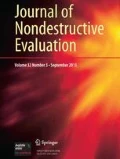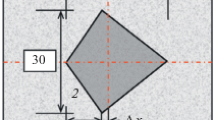Abstract
The paper describes an algorithm developed to enhance the analysis (manual or automatic) of radiographic images acquired for samples of complex geometry (such as those enabled by additive manufacturing techniques), where the imprint of the sample’s geometric complexity in the radiograph is likely to undermine the ability to identify defect indications. The underlying premise is that, assuming the sample geometry is known (at least the CAD specification), a simulation of the experimental radiograph can be used to essentially subtract out the geometric complexity from an experimental image, revealing the deviations from the expected inspection output. The approach is especially relevant when the uniqueness of the sample (for example due to personal customisation) limits the availability of comparable experimental data. However, in practice, this technique requires the simulation to be accurately calibrated to the experimental configuration, necessitating the use of a numerical optimisation to fit the simulation parameters. As a by-product, the parameters of an imperfectly specified experimental set-up are recovered. The algorithm architecture described can operate on multiple input radiographs simultaneously, and is readily adaptable to other image-based inspection modalities. Results for several test inputs are presented, starting with synthetic test cases and ending with a set of three experimental radiographs. The results are convincing, as a difference image enables a substantial reduction in image bit-depth, making deviations of interest more apparent and demonstrating the value of the approach.













Similar content being viewed by others
References
aRTist—Analytical RT Inspection Simulation Tool. http://artist.bam.de (2015). Accessed 06 July, 15
Brierley, N., Tippetts, T., Cawley, P.: Data fusion for automated non-destructive inspection. Proceed. R. Soc. Lond. 470(2167) (2014). https://doi.org/10.1098/rspa.2014.0167. http://rspa.royalsocietypublishing.org/content/470/2167/20140167
Brierley, N., C. Bellon, C., Lazaro Toralles, B.: Optimized multi-shot imaging inspection design. Proc. R. Soc. Lond. A 474(2216) (2018). https://doi.org/10.1098/rspa.2017.0319. http://rspa.royalsocietypublishing.org/content/474/2216/20170319
Chelouah, R., Siarry, P.: Genetic and Nelder-Mead algorithms hybridized for a more accurate global optimization of continuous multiminima functions. Eur. J. Oper. Res. 148(2), 335–348 (2003). https://doi.org/10.1016/S0377-2217(02)00401-0
Chiffre, L.D., Carmignato, S., Kruth, J.P., Schmitt, R., Weckenmann, A.: Industrial applications of computed tomography. CIRP Ann. Manuf. Technol. 63(2), 655–677 (2014). https://doi.org/10.1016/j.cirp.2014.05.011. http://www.sciencedirect.com/science/article/pii/S0007850614001930
Chu, W., Gao, X., Sorooshian, S.: A new evolutionary search strategy for global optimization of high-dimensional problems. Inform. Sci. 181(22), 4909–4927 (2011). https://doi.org/10.1016/j.ins.2011.06.024
Clarke, T.: Guided wave health monitoring of complex structures. Ph.D. thesis, Imperial College London, Department of Mechanical Engineering (2009)
Federal Institute for Materials Research and Testing, Germany. http://www.bam.de/en/kompetenzen/fachabteilungen/abteilung_8/fg83/index.htm (2015). Accessed 06 July, 2015
GOM: GOM ATOS Triple Scan. http://www.gom.com/metrology-systems/atos/atos-triple-scan.html (2017). Accessed 17 Aug, 2017
Haith, M.I., Huthwaite, P., Lowe, M.J.: Defect characterisation from limited view pipeline radiography. NDT E Int. 86, 186–198 (2017). https://doi.org/10.1016/j.ndteint.2016.12.007. http://www.sciencedirect.com/science/article/pii/S0963869516302808
Haith, M.I., Ewert, U., Hohendorf, S., Bellon, C., Deresch, A., Huthwaite, P., Lowe, M.J., Zscherpel, U.: Radiographic modelling for NDE of subsea pipelines. NDT E Int. 86, 113–122 (2017). https://doi.org/10.1016/j.ndteint.2016.11.006
Hopkinson, N., Hague, R., Dickens, P.: Rapid Manufacturing: An Industrial Revolution for the Digital Age. Wiley, Hoboken, NJ (2006)
Marinovszki, Á., Beenhouwer, J.D., Sijbers, J.: An efficient CAD projector for X-ray projection based 3D inspection with the ASTRA toolbox. In: 8th Conference on industrial computed tomography (2018)
Olin, B., Meeker, W.: Applications of statistical methods to nondestructive evaluation. Technometrics 38(2), 95–111 (1996)
Staude, A., Bartscher, M., Ehrig, K., Goebbels, J., Koch, M., Neuschaefer-Rube, U., Nötel, J.: Quantification of the capability of micro-ct to detect defects in castings using a new test piece and a voxel-based comparison method. NDT E Int. 44(6), 531–536 (2011). https://doi.org/10.1016/j.ndteint.2011.05.006. www.sciencedirect.com/science/article/pii/S0963869511000673
Stavroulakis, P.I., Chen, S., Sims-Waterhouse, D., Piano, S., Southon, N., Bointon, P., Leach, R.: Combined use of a priori data for fast system self-calibration of a non-rigid multi-camera fringe projection system. Proc. SPIE 10330, 10330–10330–12 (2017). https://doi.org/10.1117/12.2269302
Szeliski, R.: Computer vision: Algorithms and applications. http://szeliski.org/Book/ (2010)
Todoro, E., Spencer, R., Gleeson, S., Jamshidinia, M., Kelly, S.M.: America makes: National additive manufacturing innovation institute (NAMII) project 1: Nondestructive evaluation (NDE) of complex metallic additive manufactured (AM) structures. http://www.dtic.mil/dtic/tr/fulltext/u2/a612775.pdf (2014)
Valavanis, I., Kosmopoulos, D.: Multiclass defect detection and classification in weld radiographic images using geometric and texture features. Expert Syst. Appl. 7(12), 606–7614 (2010). https://doi.org/10.1016/j.eswa.2010.04.082. http://www.sciencedirect.com/science/article/pii/S0957417410003829
Walsh, T.: General Symmetry Breaking Constraints, pp. 650–664. Springer, Berlin (2006)
Wang, Z., Bovik, A.C., Sheikh, H.R., Simoncelli, E.P.: Image quality assessment: from error visibility to structural similarity. IEEE Trans. Image Process. 13(4), 600–612 (2004). https://doi.org/10.1109/TIP.2003.819861
Xue, Y., Zhong, S., Zhuang, Y., Xu, B.: An ensemble algorithm with self-adaptive learning techniques for high-dimensional numerical optimization. Appl. Math. Comput. 231, 329–346 (2014). https://doi.org/10.1016/j.amc.2013.12.130
Acknowledgements
I thank my colleagues Borja Lazaro Toralles, Silvia Estelles-Martinez and Matteo Villa for taking on some of the supporting tasks. This work was completed as part of a Core Research Programme project at the MTC, and funded, including the article processing charge, by industrial membership fees and the UK High Value Manufacturing Catapult. The authors are grateful to Imperial College London and Trevor Tippetts, formerly of Imperial College London (now Los Alamos National Laboratory), for permitting the code base developed during the author’s doctorate in collaboration with Trevor Tippetts to be reused and built on for the purposes of this project. The author would like to thank Peter Kinnell of the University of Loughborough and Peter Cawley of Imperial College London for feedback on a draft of this paper. Finally, the project is indebted to the open source community and all the contributors to the open source code libraries that the program has been built on.
Author information
Authors and Affiliations
Corresponding author
Additional information
Publisher's Note
Springer Nature remains neutral with regard to jurisdictional claims in published maps and institutional affiliations.
Rights and permissions
About this article
Cite this article
Brierley, N. Simulation-Based Analysis of Complex Radiographic Images. J Nondestruct Eval 39, 51 (2020). https://doi.org/10.1007/s10921-020-00696-z
Received:
Accepted:
Published:
DOI: https://doi.org/10.1007/s10921-020-00696-z




